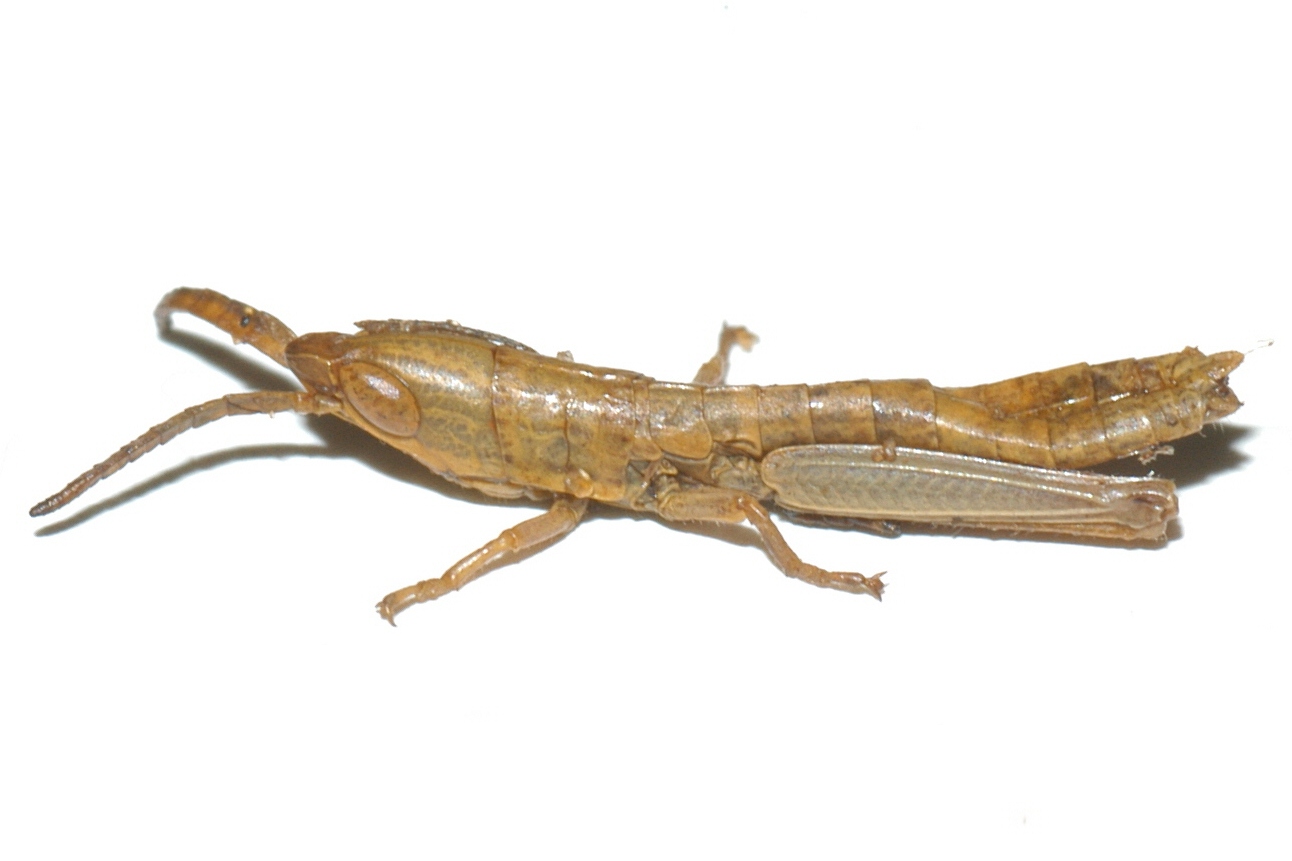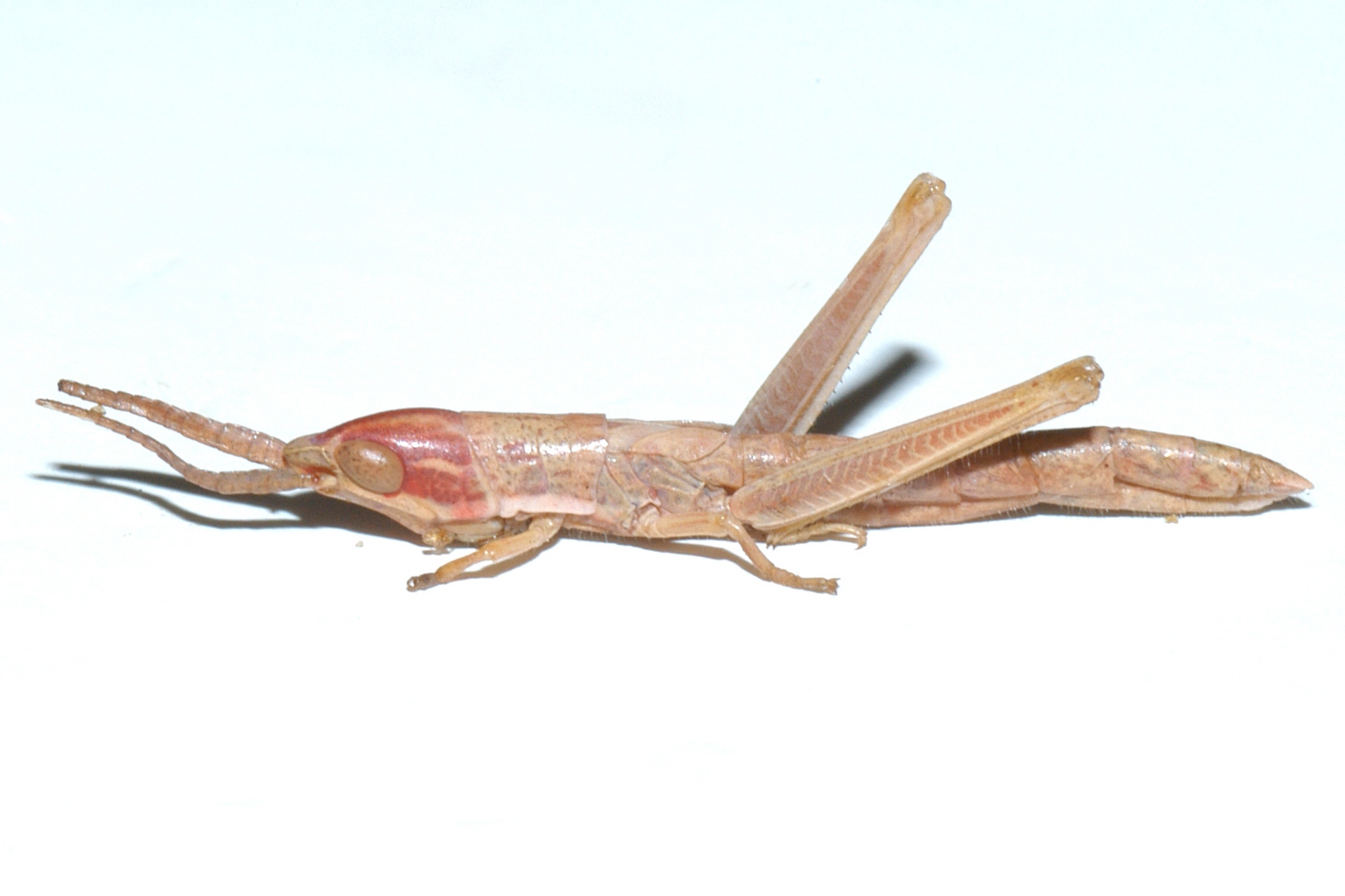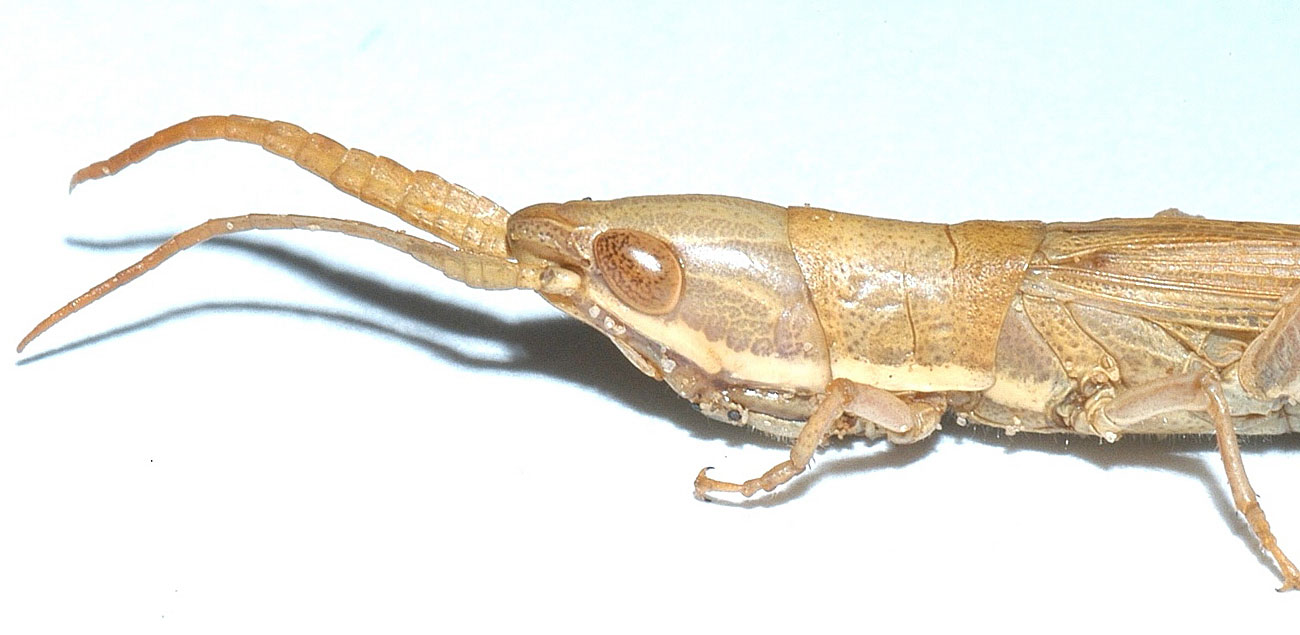Paropomala wyomingensis
|
Geographic range of Paropomala wyomingensis (Thomas) |
|
Fig. 1, second instar |
|
Fig. 2, fourth instar |
|
Fig. 3, fifth instar |
|
Fig. 4, adult male: BL 21-27 mm, FL 9-13 mm, AS 22-24 |
|
Fig. 5, adult female (green phase): BL 27-34 mm, FL 10-15 mm, AS 22-24 |
|
Fig. 6, adult female (brown phase): BL 27-34 mm, FL 10-15 mm, AS 22-24 |
|
Fig. 7, closeup of lateral pronotum |
Species
Wyoming toothpick grasshopper
Paropomala wyomingensis (Thomas)
Subfamily Gomphocerinae
Identification
The Wyoming toothpick grasshopper is a small and extremely slender grasshopper. Adult females are larger and generally more robust than males. Unlike most other gomphocerines, the Wyoming toothpick grasshopper does have a spine visible in the prosternum. The color of the females may be light brown or green, while males are always light brown. The head is prominently slanted, and the mouth is located well behind the eyes. The head is conspicuously cone-shaped near the end, distinctly narrowing both dorsally and ventrally immediately in front of the eyes. There is a pale brownish to whitish line that extends from the base of the antennae and below the eyes to above the mouth along the lower edge of the face. This pale line continues along the lower quarter of the side of the pronotum and mesothorax. There is also a somewhat indistinct darker band extending from the eye along the sides of the pronotum. The antennae are distinctly ensiform. The front legs are short and even when fully extended, do not reach the tip of the head. The wings normally reach about two-thirds to three-quarters the distance to the end of the abdomen. The outer hind femur is light brown or greenish, consistent with the ground color of the individual. The inner femur color is similar to that of the outer surface, and the tibiae also follow this trend. The subgenital plate is very long and pointed. An early reference to this genus having a short subgenital plate is inaccurate. Instead, the subgenital plate of the male is long and pointed.
Distribution and habitat
The Wyoming toothpick grasshopper occurs from southern California and Wyoming to southern South Dakota, central Nebraska, central Oklahoma, western Texas, and south into Mexico. It occurs among grass clumps in short-grass prairie as well as desert grasslands. In deserts it is more common in taller grasses of depressions.
Economic importance
It seldom occurs in high densities, and is thus of little economic importance.
Food preferences
The Wyoming toothpick grasshopper feeds on coarse grasses, particularly western wheatgrass, bluegrass, needleandthread, blue grama, sand dropseed, threeawn, sunsedge, Indian ricegrass, big bluestem, and little bluestem. It has also been reported to feed on milkvetch. The chief host in Colorado bluegrass, Andropogon glaucum.
Dispersal and migration
Adults are generally reluctant to jump or fly and prefer to rely on crypsis, often hugging tightly to grass blades and remaining motionless. They usually cling to grass stems with its short front legs and are difficult to flush. Upon escaping they make short flights and immediately seek other clumps of grass. As a result of their weak flight dispersal is expected to be limited.
Hatching
It is thought to be in the intermediate hatching group.
Nymphal development
Nymphs molt through five instars and are most commonly noted in June and July. It overwinters in the egg stage.
Adults and reproduction
Adults occur in the same areas as nymphs develop. The very short fore and middle legs suggest this grasshopper is highly specialized for living on stems. Males approaching females make a single accoustical signal. Occasionally females are approached without stridulation. Adults are most common from July to October in Arizona and late June to October in Colorado.
Population ecology
The population ecology of the Wyoming toothpick grasshopper has not been studied in detail. Populations are likely localized to areas with an abundance of coarse grasses.
Daily activity
The daily activity of this grasshopper has not been studied.
Source and date
University of Nebraska March 2007 by Mathew L. Brust
Selected references
Ball, E. D., E. R. Tinkham, R. Flock, and C. T. Vorhies. 1942. The grasshoppers and other Orthoptera of Arizona. Arizona Agriculture Experiment Station Technical Bulletin 93: 255-373.
Capinera, J. L. and T. S. Sechrist. 1982. Grasshoppers (Acrididae) of Colorado: Identification, biology and management. Colorado State University Experiment Station Bulletin No. 5848. 161 pp.
Coppock, S., Jr. 1962. The grasshoppers of Oklahoma (Orthoptera: Acrididae). Oklahoma Agriculture Experiment Station Processed Series P-399: 1-143.
Gillette, C. P. 1904. Annotated list of Colorado Orthoptera. Colorado Agriculture Experiment Station Bulletin 94: 17-67.
Hebard, M. 1925. The Orthoptera of South Dakota. Proceedings of the Academy of Natural Sciences, Philadelphia 77: 35-155.
Hebard, M. 1929. The Orthoptera of Colorado. Proceedings of the Academy of Natural Sciences, Philadelphia 81: 303-425.
Helfer, J. R. 1987. How to Know the Grasshoppers, Crickets, Cockroaches and Their Allies. Dover Publications Inc. New York, New York. 363 pp.
LaRivers, I. 1948. A synopsis of Nevada Orthoptera. American Midland Naturalist 39: 652-720.
Otte, D. 1970. A comparative study of communicative behavior in grasshoppers. Miscellaneous Publications of the University of Michigan Museum of Zoology no. 141: 1-168.
Otte, D. 1981. The North American grasshoppers, Volume I, Acrididae: Gomphocerinae and Acridinae. Harvard University Press, Cambridge, Massachusetts. 368 pp.
Scoggan, A. C., and M. A. Brusven. 1972. Differentiation and ecology of common immature Gomphocerinae and Oedipodinae (Orthoptera: Acrididae) of Idaho and adjacent areas. Melanderia 8: 1-76.





